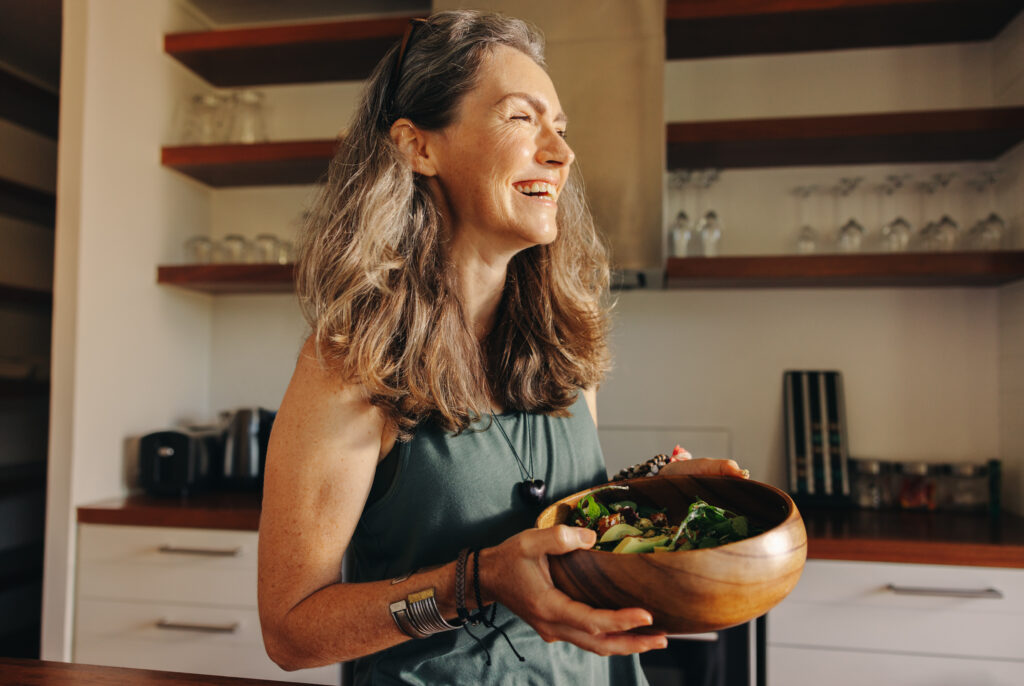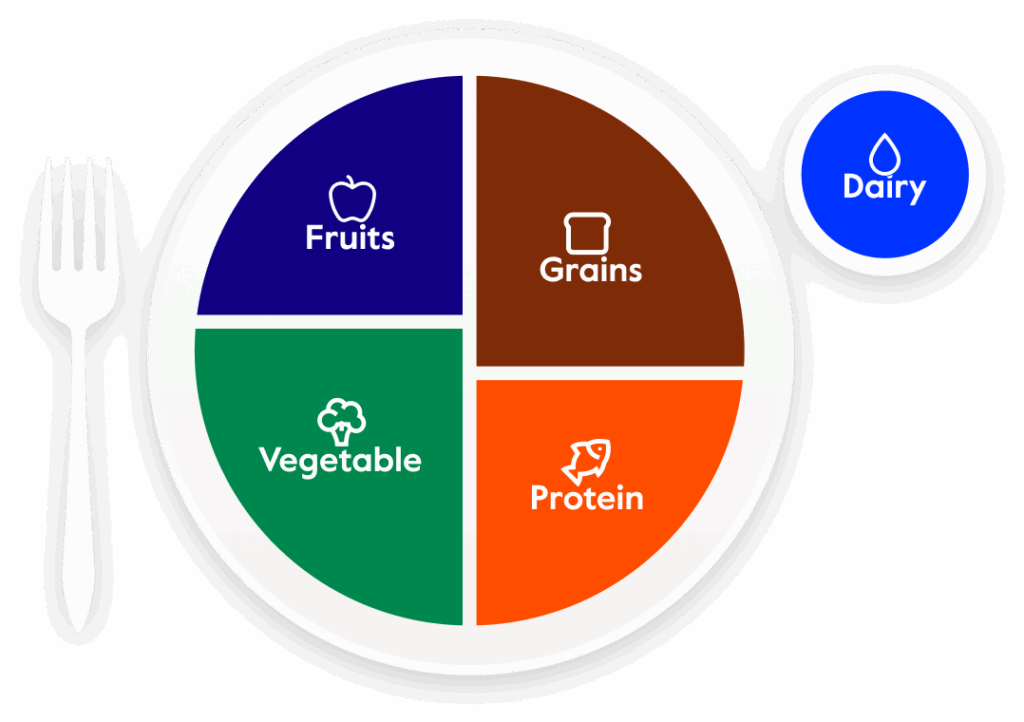Small changes in what you eat today can lead to a healthier tomorrow. What you eat each day is more than just a choice—it’s a step toward a healthier you.
Choosing healthy foods helps fuel your body, sharpen your mind and create a strong starting point for lifelong wellness. You can build habits that fit your lifestyle while still honoring the cultural traditions that make food meaningful.

Why nutrition matters
Good nutrition is a simple but powerful way to take care of yourself. Eating well helps you stay healthy, avoid illness, and prevent and handle long-term health issues, including obesity, heart disease, diabetes and high blood pressure.1
Food connects us. It’s a way to celebrate, bring people together and share love. You don’t have to give up the dishes you enjoy or the flavors that are part of your culture to eat well. Small changes can make your meals a little healthier without losing what makes them special. Whether it’s tweaking an ingredient or trying a new cooking method, every step you take counts toward a healthier you.
Get personalized support to build healthier habits and achieve your goals.
Create a personalized food plan.
Everyone’s nutritional needs are different. Use MyPlate17 to create a personal food plan based on your age, sex, height, weight and physical activity level.
Keep in mind that serving sizes on nutrition labels are based on the amount that people typically eat or drink, not the amount they should eat or drink. And remember, your plate doesn’t have to look perfect; it’s more about balance.
Talk with your doctor or a registered dietitian (RD) to create meal plans that fit your needs and goals.
Your culture and nutrition
The meals we enjoy are often tied to our traditions and heritage, making them uniquely special. Let’s celebrate these flavors and ingredients, along with a few healthy twists to support your well-being.

Hispanic/Latino community
Hispanic/Latino food is often full of naturally healthy vegetables and proteins. If you’re looking to make your meals even healthier, small tweaks can make a big difference. You can still enjoy the foods you love without giving up flavor or tradition.
- Switch from white rice to brown rice to get more fiber and support steady blood sugar.
- Choose fish or ceviche for a lighter, delicious meal. Canned fish can be part of a healthy diet too.3
- Try roasting or baking dishes that are more traditionally fried to cut back on dietary fat.
- Add flavor with fresh herbs, lime or garlic rather than higher-sodium seasonings.
- Fill half your plate with colorful, non-starchy veggies to make your meals more balanced and satisfying.
Talk to a Registered Dietitian (RD) for more tips. You can get help creating a meal plan that fits your lifestyle and goals.
African American/Black community
Many ingredients used in African American/Black cuisine are wholesome and packed with nutrients. If you’re looking to make your meals even healthier, small tweaks can make a big difference, letting you enjoy the foods you love without giving up flavor or tradition.
- Use smoked turkey or turkey sausage (90% lean or more) as a flavorful option instead of meats with higher fat content.
- Season with garlic powder, onion powder or salt-free condiments instead of higher-sodium options.
- Consider roasting or sautéing vegetables rather than boiling them to keep more of their nutrients and cut back on dietary fat.
- Cook with heart-healthy oils, such as olive or avocado, instead of vegetable oil, butter or margarine.5
- Choose low-fat milk, almond milk or coconut milk instead of whole milk to cut down on saturated fat.
Talk to a Registered Dietitian (RD) for more tips. You can get help creating a meal plan that fits your lifestyle and goals.


South Asian community
South Asian food typically features plenty of healthy and good-for-you ingredients. If you’re looking to make your meals even healthier, small tweaks can make a big difference. You can still enjoy the foods you love without giving up flavor or tradition.
- Try oven-frying or pan-frying instead of deep-frying to enjoy your favorite foods with less oil, cutting back on dietary fat.
- Add more fermented foods, such as yogurt or kimchi, to support a healthy gut.
- Include more non-starchy vegetables, such as cauliflower and broccoli, for added fiber.
- Enjoy fried foods every once in a while, or try baking or air frying for a lighter option.
Talk to a Registered Dietitian (RD) for more tips. You can get help creating a meal plan that fits your lifestyle and goals.

Try simple and healthy food swaps.
Swap for unsweetened applesauce, mashed banana or a no-calorie sweetener that works for cooking and baking.7
Why swap? These options can add sweetness to baked goods while cutting down on added sugar.8
Tip: Try one in your favorite cookie or cake recipe.
Swap for olive oil or avocado oil.
Why swap? These oils are better for your heart.9
Tip: Choose a cooking oil that’s lower in saturated fat for a healthier option.9 Look for “polyunsaturated” or “monounsaturated” fats on the nutrition label.
Swap for quinoa or black or brown rice.
Why swap? These grains have more fiber and nutrients, giving you energy that lasts.10
Tip: Mix quinoa into salads for an extra boost.10
Swap for ground turkey or a plant-based protein.
Why swap? Ground turkey is lower in saturated fat, and plant-based proteins, such as lentils or beans, offer heart-healthy benefits.11
Tip: Spice it up with your favorite seasonings and veggies.11
Swap for sparkling water or infused water.
Why swap? You’ll skip the added sugar but keep the fizz or flavor.12
Tip: Add fresh fruit or herbs to your water for natural flavor.12
Swap for whole-grain bread.
Why swap? Whole grains help you stay full longer and are great for heart health.13
Tip: Look for “100% whole grain” on the label to make the healthiest choice.13
Swap for grilled, baked or pan-fried versions.
Why swap? These choices keep the flavor while cutting back on unhealthy fats.14
Tip: An air fryer or convection oven can help crisp food using 70%–80% less oil.14
Swap for fresh papayas, mangoes, guavas and figs.
Why swap? Natural sugars are a healthier choice for a sweet treat.15
Tip: Save street-food-style fruit, which may include added sugars, for special occasions.15
Swap for broccoli, asparagus, peppers, mushrooms and other non-starchy vegetables.
Why swap? Non-starchy vegetables have fewer carbs and calories.16
Tip: Steam or roast them for a tasty, healthy side dish.16
Reduced-cost food assistance
Quickly search and connect with hundreds of organizations near you.
Find local food pantries, home-delivery meal services, food stamp assistance and more.
Visit cignacommunity.findhelp.com for more info.
Resources and tools
Ready to make the next step in your health journey? Your future needs you, and a healthier tomorrow starts with the actions you take now. Explore these tools to maintain your health, prevent illness and lower health care costs.
Use personalized tools
Access health information anytime, anywhere.
Download the myCigna App:

This information is for educational purposes only. It is not medical advice. Always consult your doctor for appropriate examinations, treatment, testing and care recommendations. Any third-party content is the responsibility of such third party. Cigna Healthcare® does not endorse or guarantee the accuracy of any third-party content and is not responsible for such content. Your access to and use of this content is at your sole risk.
Cigna Healthcare products and services are provided exclusively by or through operating subsidiaries of The Cigna Group.
- Centers for Disease Control and Prevention (CDC). “Benefits of Healthy Eating for Adults.” February 14, 2024. https://www.cdc.gov/nutrition/php/resources/healthy-eating-benefits-for-adults.html
- Cigna Healthcare. Diabetes in the Hispanic/Latino(a) Community: Four Case Studies. June 2022. https://www.cigna.com/static/www-cigna-com/docs/diabetes-in-hispanic-latino-community-four-case-studies.pdf
- American Heart Association. “Picking Healthy Proteins.” Last reviewed August 28, 2024. https://www.heart.org/en/healthy-living/healthy-eating/eat-smart/nutrition-basics/picking-healthy-proteins
- Cigna Healthcare. Diabetes Among African Americans/Blacks in the United States. June 2021. https://www.cigna.com/static/www-cigna-com/docs/diabetes-among-african-americans-patient-guide.pdf
- Dennett C. “Healthful Oils: Myths and Facts About Seed Oils.” Today’s Dietitian. June/July 2023. https://www.todaysdietitian.com/newarchives/0623p18.shtml
- Cigna Healthcare. South Asians and Heart Health: Take Control Now. February 2022. https://www.cignaproducer.com/heart-health/
- American Heart Association. “Life Is Sweet With These Easy Sugar Swaps Infographic.” Last updated December 31, 2024. https://www.heart.org/en/healthy-living/healthy-eating/eat-smart/sugar/life-is-sweet-with-these-easy-sugar-swaps-infographic
- Kubala J. “10 Alternatives to Refined Sugar.” Healthline. Last updated April 19, 2023. https://www.healthline.com/nutrition/natural-sugar-substitutes
- MedlinePlus. “Butter, margarine, and cooking oils.” Last reviewed August 5, 2024. https://medlineplus.gov/ency/patientinstructions/000095.htm
- Lawler M. “Quinoa vs. Rice: Which Is Healthier?” Everyday Health. July 18, 2024. https://www.everydayhealth.com/diet-nutrition/quinoa-vs-rice-which-is-healthier/
- Mayer BA. “Ground Turkey vs Ground Beef: Which One’s Healthier?” Parade. November 3, 2024. https://parade.com/health/is-ground-turkey-healthier-than-ground-beef-nutrition-according-to-registered-dietitians
- Jacoby S. “Looking for a healthy soda? Dietitians share their 6 favorite alternatives.” Today. June 10, 2024. https://www.today.com/health/diet-fitness/healthiest-soda-rcna155894
- Gold B. “What’s the Difference Between Whole Wheat, Whole Grain, and Multigrain Bread?” Real Simple. February 28, 2025. https://www.realsimple.com/food-recipes/cooking-tips-techniques/whole-wheat-whole-grain-breads-0
- McDonnell K. “Why Are Fried Foods Bad for You?” Healthline. Last updated June 7, 2023. https://www.healthline.com/nutrition/why-fried-foods-are-bad
- American Heart Association. “Sugar 101.” Last reviewed September 23, 2024. https://www.heart.org/en/healthy-living/healthy-eating/eat-smart/sugar/sugar-101
- Coyle D. “What’s the Difference Between Starchy and Non-Starchy Vegetables?” Healthline. Last updated October 16, 2024. https://www.healthline.com/nutrition/starchy-vs-non-starchy-vegetables
- U.S. Department of Agriculture (USDA). “MyPlate.” n.d. http://www.myplate.gov
